 Cute, Creepy, and Quirky Projects to Make with Beads, Wire, and Fun Found Objects AMY KOPPERUDE contents introduction Y our backyard is teeming with life. From slimy and slithery to colorful and shimmery, the bugs and small creatures that move about under rocks, through underground tunnels, and beneath the waters surface, even those that scamper in the trees or float on the breeze, are natures wonders. And they come to life in this book in a way that might never have occurred to you. Bead Bugs provides 23 different projects to help you experiment with a type of beading that includes found and recycled objects. Tired of making the same necklaces and earrings? This book presents beaded projects that are more than fashion accessories or jewelry pieces. When you shop for craft materials, think about how you can recreate the world around you with beads and other findings. After paging through Bead Bugs, you may want to visit your local bead store and think about how different shapes and colors of beads can be used to create altered versions of these small living beings.
Cute, Creepy, and Quirky Projects to Make with Beads, Wire, and Fun Found Objects AMY KOPPERUDE contents introduction Y our backyard is teeming with life. From slimy and slithery to colorful and shimmery, the bugs and small creatures that move about under rocks, through underground tunnels, and beneath the waters surface, even those that scamper in the trees or float on the breeze, are natures wonders. And they come to life in this book in a way that might never have occurred to you. Bead Bugs provides 23 different projects to help you experiment with a type of beading that includes found and recycled objects. Tired of making the same necklaces and earrings? This book presents beaded projects that are more than fashion accessories or jewelry pieces. When you shop for craft materials, think about how you can recreate the world around you with beads and other findings. After paging through Bead Bugs, you may want to visit your local bead store and think about how different shapes and colors of beads can be used to create altered versions of these small living beings.
Then, step out of the bead aisle, or even the bead store, and explore other materials that can be used to embellish your creation: ribbon, spacer bars, yarn and fabric, nuts and washers from the hardware store, metal screen, twigs and seeds from outside, even materials from the recycling bin. In a market flooded with both handmade and commercially made beading supplies, the world is your oyster. (Heck, you can probably make an oyster using beads and other materials.) Take apart something broken to see if you can imagine something new. Whether you rely on step-by-step instructions or would rather think outside of the box to create, you will find that many of the creature creations in this book have similar constructions and you need only to vary technique and beads to come up with your own bug once you have mastered some of the bugs presented here. Any one of these beaded projects affords an opportunity for a handmade gift, the very best kind of gift there is.  tools & materials O nly a few tools are needed to make the projects in this book.
tools & materials O nly a few tools are needed to make the projects in this book.  tools & materials O nly a few tools are needed to make the projects in this book.
tools & materials O nly a few tools are needed to make the projects in this book.
You may already have what you need, especially if you have dabbled in making bead jewelry. All of these tools and materials can be found at your craft store.
TOOLS
 Round-Nose Pliers (a):
Round-Nose Pliers (a): Use round-nose pliers to create loops when beginning a spiral or finishing ends.
 Flat-Nose Pliers (b):
Flat-Nose Pliers (b): Use flat-nose pliers to make flat spirals (as for antennae), secure wire loop closures, bend wire at a specific angle, and tighten or adjust pieces of wire.
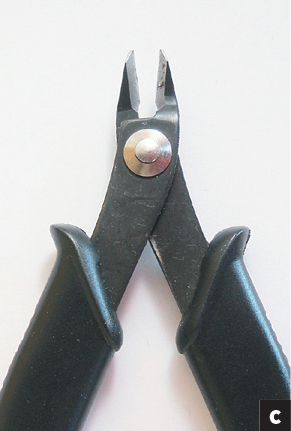 Wire Cutters (c):
Wire Cutters (c): Use wire cutters to cut wire to the desired length or trim wire for finishing touches.
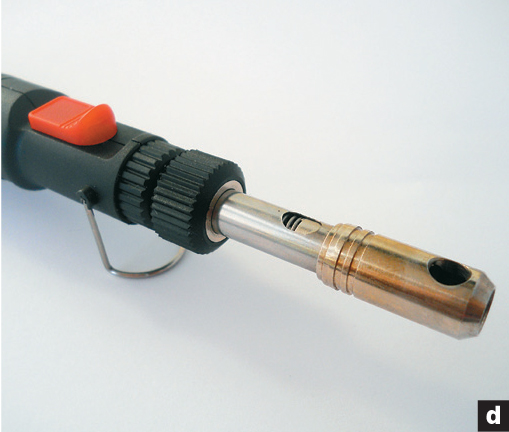 Mini Butane Torch (d):
Mini Butane Torch (d): Use a butane torch for flame-coloring copper screen for bug wings.
WIRE AND CORD
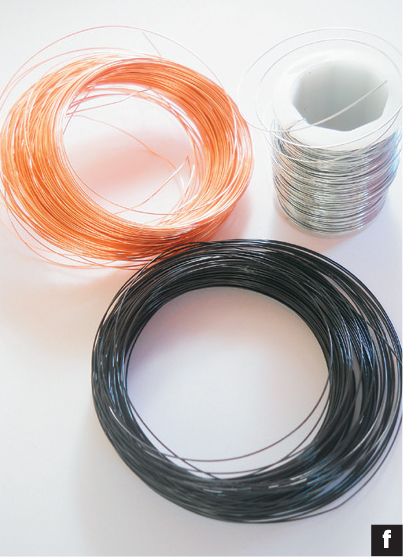 18- or 12-Gauge (f):
18- or 12-Gauge (f): Heavier gauge wires are typically only suitable for very large beads or structures (e.g., bat mobile, ); 12-gauge wire is found in the floral section of most craft stores.
20-Gauge: This heavy-gauge wire works well for hangers (e.g., Seahorse Ornament, ).
22-Gauge: This gauge of wire is the preferred thickness for projects that require more stability (e.g., Spider Pin, ).
22-Gauge: This gauge of wire is the preferred thickness for projects that require more stability (e.g., Spider Pin, ).
Its just pliable enough to be considered sturdy but not so thick that most seed and bugle beads wont slide onto the wire, as happens with the 20-gauge wire. 24-Gauge: Somewhat more pliable than 22-gauge wire, 24-gauge wire works well for threading beads that are too small to fit on 22-gauge wire. 26- or 28-Gauge: Floral wire is a common 28-gauge wire, which can be used for projects that are lightweight (e.g., Spider Suncatcher, ). It is also very easy to maneuver with hands rather than tools. 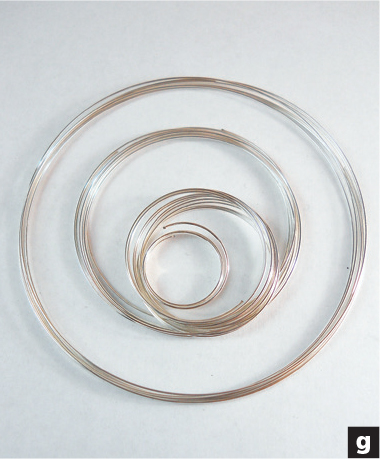 Memory Wire (g): Memory wire is preshaped circular wire that is used for making hoop-shaped necklaces, spiral bracelets, and rings.
Memory Wire (g): Memory wire is preshaped circular wire that is used for making hoop-shaped necklaces, spiral bracelets, and rings.
BEADS
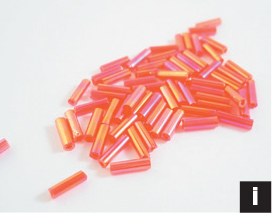 Bugle Beads (i):
Bugle Beads (i): Small tubelike beads typically made of glass
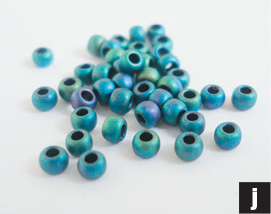 Seed Beads (j):
Seed Beads (j): Very small round beads used for intricate designs
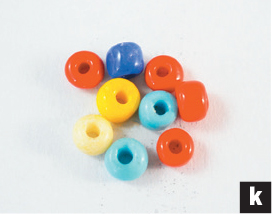 E Beads (k):
E Beads (k): E beads or beads with a 6/0 measurement are slightly larger than seed beads and are often solid colored plastic or glass and simple in design
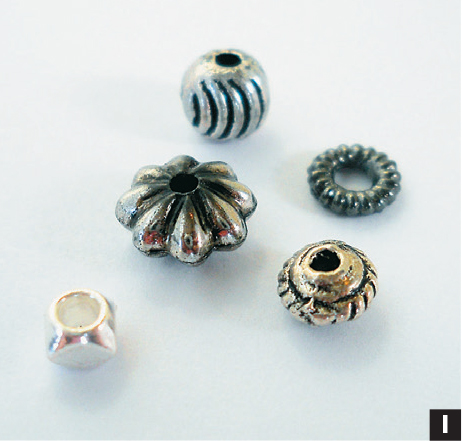 Spacer Beads (l):
Spacer Beads (l): The beads used to separate or give space to the surrounding beads; they are typically smaller or shorter than other beads and often are metal
 Rondelle/Disk Beads (a):
Rondelle/Disk Beads (a): Flat saucerlike beads that have a shorter height than width
 Bicone Beads (b):
Bicone Beads (b): Small faceted beads that are decorative and work well as spacers for bead bugs
 Drop/Teardrop Beads (c):
Drop/Teardrop Beads (c): Pear-shaped beads with a hole that runs through the narrow tip or through the center of the bead from narrow end to widest end




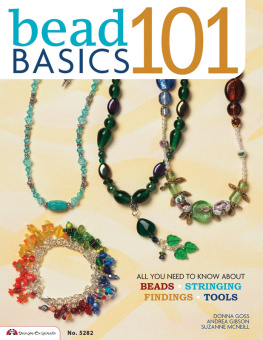

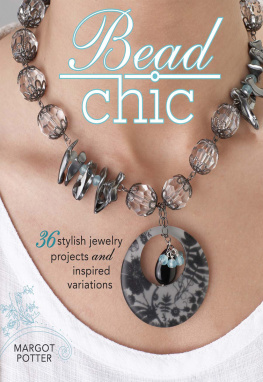
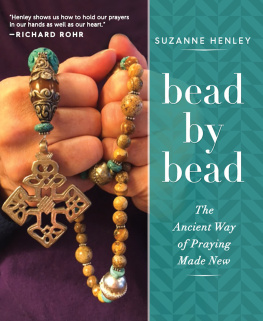
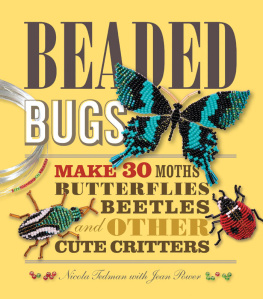
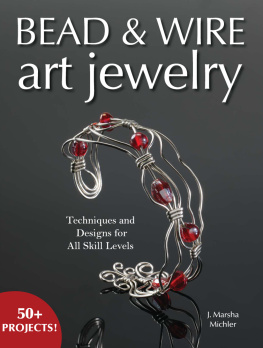
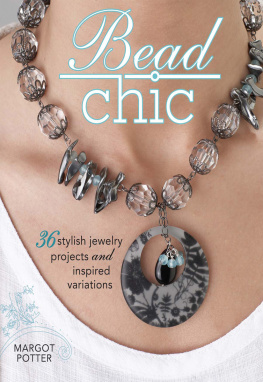
 Cute, Creepy, and Quirky Projects to Make with Beads, Wire, and Fun Found Objects AMY KOPPERUDE contents introduction Y our backyard is teeming with life. From slimy and slithery to colorful and shimmery, the bugs and small creatures that move about under rocks, through underground tunnels, and beneath the waters surface, even those that scamper in the trees or float on the breeze, are natures wonders. And they come to life in this book in a way that might never have occurred to you. Bead Bugs provides 23 different projects to help you experiment with a type of beading that includes found and recycled objects. Tired of making the same necklaces and earrings? This book presents beaded projects that are more than fashion accessories or jewelry pieces. When you shop for craft materials, think about how you can recreate the world around you with beads and other findings. After paging through Bead Bugs, you may want to visit your local bead store and think about how different shapes and colors of beads can be used to create altered versions of these small living beings.
Cute, Creepy, and Quirky Projects to Make with Beads, Wire, and Fun Found Objects AMY KOPPERUDE contents introduction Y our backyard is teeming with life. From slimy and slithery to colorful and shimmery, the bugs and small creatures that move about under rocks, through underground tunnels, and beneath the waters surface, even those that scamper in the trees or float on the breeze, are natures wonders. And they come to life in this book in a way that might never have occurred to you. Bead Bugs provides 23 different projects to help you experiment with a type of beading that includes found and recycled objects. Tired of making the same necklaces and earrings? This book presents beaded projects that are more than fashion accessories or jewelry pieces. When you shop for craft materials, think about how you can recreate the world around you with beads and other findings. After paging through Bead Bugs, you may want to visit your local bead store and think about how different shapes and colors of beads can be used to create altered versions of these small living beings. tools & materials O nly a few tools are needed to make the projects in this book.
tools & materials O nly a few tools are needed to make the projects in this book.  Round-Nose Pliers (a): Use round-nose pliers to create loops when beginning a spiral or finishing ends.
Round-Nose Pliers (a): Use round-nose pliers to create loops when beginning a spiral or finishing ends.  Flat-Nose Pliers (b): Use flat-nose pliers to make flat spirals (as for antennae), secure wire loop closures, bend wire at a specific angle, and tighten or adjust pieces of wire.
Flat-Nose Pliers (b): Use flat-nose pliers to make flat spirals (as for antennae), secure wire loop closures, bend wire at a specific angle, and tighten or adjust pieces of wire.  Wire Cutters (c): Use wire cutters to cut wire to the desired length or trim wire for finishing touches.
Wire Cutters (c): Use wire cutters to cut wire to the desired length or trim wire for finishing touches.  Mini Butane Torch (d): Use a butane torch for flame-coloring copper screen for bug wings.
Mini Butane Torch (d): Use a butane torch for flame-coloring copper screen for bug wings.  18- or 12-Gauge (f): Heavier gauge wires are typically only suitable for very large beads or structures (e.g., bat mobile, ); 12-gauge wire is found in the floral section of most craft stores. 20-Gauge: This heavy-gauge wire works well for hangers (e.g., Seahorse Ornament, ). 22-Gauge: This gauge of wire is the preferred thickness for projects that require more stability (e.g., Spider Pin, ). 22-Gauge: This gauge of wire is the preferred thickness for projects that require more stability (e.g., Spider Pin, ).
18- or 12-Gauge (f): Heavier gauge wires are typically only suitable for very large beads or structures (e.g., bat mobile, ); 12-gauge wire is found in the floral section of most craft stores. 20-Gauge: This heavy-gauge wire works well for hangers (e.g., Seahorse Ornament, ). 22-Gauge: This gauge of wire is the preferred thickness for projects that require more stability (e.g., Spider Pin, ). 22-Gauge: This gauge of wire is the preferred thickness for projects that require more stability (e.g., Spider Pin, ).  Memory Wire (g): Memory wire is preshaped circular wire that is used for making hoop-shaped necklaces, spiral bracelets, and rings.
Memory Wire (g): Memory wire is preshaped circular wire that is used for making hoop-shaped necklaces, spiral bracelets, and rings. Bugle Beads (i): Small tubelike beads typically made of glass
Bugle Beads (i): Small tubelike beads typically made of glass  Seed Beads (j): Very small round beads used for intricate designs
Seed Beads (j): Very small round beads used for intricate designs  E Beads (k): E beads or beads with a 6/0 measurement are slightly larger than seed beads and are often solid colored plastic or glass and simple in design
E Beads (k): E beads or beads with a 6/0 measurement are slightly larger than seed beads and are often solid colored plastic or glass and simple in design  Spacer Beads (l): The beads used to separate or give space to the surrounding beads; they are typically smaller or shorter than other beads and often are metal
Spacer Beads (l): The beads used to separate or give space to the surrounding beads; they are typically smaller or shorter than other beads and often are metal  Rondelle/Disk Beads (a): Flat saucerlike beads that have a shorter height than width
Rondelle/Disk Beads (a): Flat saucerlike beads that have a shorter height than width  Bicone Beads (b): Small faceted beads that are decorative and work well as spacers for bead bugs
Bicone Beads (b): Small faceted beads that are decorative and work well as spacers for bead bugs  Drop/Teardrop Beads (c): Pear-shaped beads with a hole that runs through the narrow tip or through the center of the bead from narrow end to widest end
Drop/Teardrop Beads (c): Pear-shaped beads with a hole that runs through the narrow tip or through the center of the bead from narrow end to widest end 